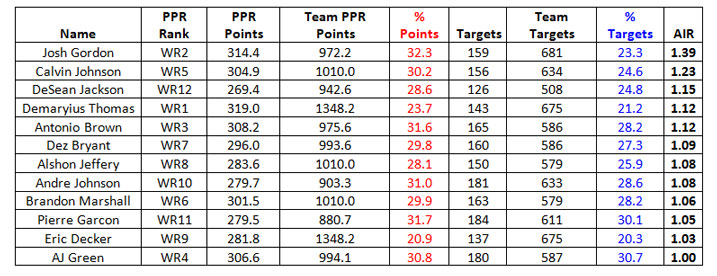AIR: The Results
Editor’s Note: We published an article today in our free content describing AIR, or the Adjusted Improvement Ratio. For a complete breakdown of the idea behind AIR, make sure you check it out.
To tabulate AIR, I created and followed the following formula:
AIR = % of Team’s PPR Receiving Points / % of Team’s Targets
In a test analysis, AIR data was derived for the top-12 PPR receivers, and is summarized below. Also, each player’s PPR rank was included in order to highlight any discrepancies. Finally, brief analyses for each player are included, highlighting what their AIR signifies.

Josh Gordon, WR CLE
Honestly, if you can find a metric that makes this guy look bad, you’re trying too hard. Gordon’s transcendent AIR proves that he was able to achieve nearly a third of the team’s points on less than a quarter of the targets, resulting in a sublime efficiency. With better quarterback play, the sky might literally be the limit for the soon-to-be third year player.
Calvin Johnson, WR DET
Despite playing through a season-long knee injury, Johnson’s AIR was still the second best on the list. Perhaps more importantly, he showed how easily he can still get the job done even if he’s not being force-fed the ball. Despite the fact he’ll turn 29 during the 2014 season, he remains one of the game’s best receivers.
DeSean Jackson, WR PHI
We all know the narrative – he’s smaller than the prototype, his attitude stinks and he’s a one trick pony. Do yourself a favor and let your league mates believe that. Chip Kelly’s offense clearly agrees with Jackson, and if Philly expands upon the mere 508 pass attempts they put forward in 2013, he could rise even higher.
Demaryius Thomas and Eric Decker, WRs DEN
Decker is a plus-receiver who managed to make good on being the second option on a Peyton Manning-led offense. He did about what was expected of him, but didn’t elevate his market share like Thomas did. It’s certainly not news, but Decker will likely need a greater volume to mitigate the drop-off to a different quarterback. Given his ability to elevate his play relative to those around him, Thomas could benefit from additional targets.
Antonio Brown, WR PIT
Brown gets knocked by shortsighted owners who claim he was merely a product of an unrepeatable volume. The truth is actually quite the contrary – Brown benefited from volume, but was extremely efficient with it as well as evidenced by an AIR of 1.12. Still just 25 years old, Brown appears likely to replicate his WR1-level production.
Dez Bryant, WR DAL
Considering his talent, as well as the total output of the Dallas offense, Bryant’s AIR of 1.09 is mildly disappointing. This is especially true given that his 2012 AIR stood at a significantly higher 1.30. Regardless, even if he didn’t resemble his 2012 self, Bryant still outpaced the performance his volume should’ve dictated.
Alshon Jeffery and Brandon Marshall, WRs CHI
Given that the second-year Jeffery out-produced the AIR of his elder compatriot Marshall despite scoring fewer touchdowns, it’s hard not to get excited for his future. Should their targets flip-flop in 2013, it could be Jeffery who finishes as the better fantasy player. This isn’t to say Marshall is chopped liver – but it goes to show that his 2012 performance was due, at least somewhat, to his volume.
Andre Johnson, WR HOU and Pierre Garcon, WR WAS
Truthfully these are the types of players for whom the AIR metric was created. They played on the two worst offenses listed (by total fantasy points) and as such were forced to shoulder the load (31.0% and 31.7% of team points respectively). Even despite that, each managed to perform above (if only slightly) what was expected of them in terms of volume. In these cases AIR was able to elucidate what the PPT and YPT metrics missed, and expand upon the %CPPA values. Ultimately, I wouldn’t sell high on either Garcon or Johnson with the sole reason being an unrepeatable volume – put succinctly, they did what they could.
AJ Green, WR CIN
On the other side of the coin we have Green. Despite playing on the fourth most prolific offense listed, he really didn’t do anything to enhance the play of signal caller Andy Dalton. I understand it’s blasphemous to disparage Green in any way, shape or form, but the numbers don’t lie – his target share easily led the group, and he did exactly what was expected with it, nothing more. I’m not suggesting he isn’t a top dynasty asset, but if players like Garcon, Brown and Johnson catch flack for “volume-based” results, Green should too.
- Dynasty Fantasy Football Mailbag: Is Kendre Miller Valued Unfairly? - April 17, 2024
- Forgotten Dynasty Veterans: Bottom Tier - April 9, 2024
- Dynasty Fantasy Football Mailbag: How Much Should You Factor in Off-Field Issues? - April 9, 2024


































































